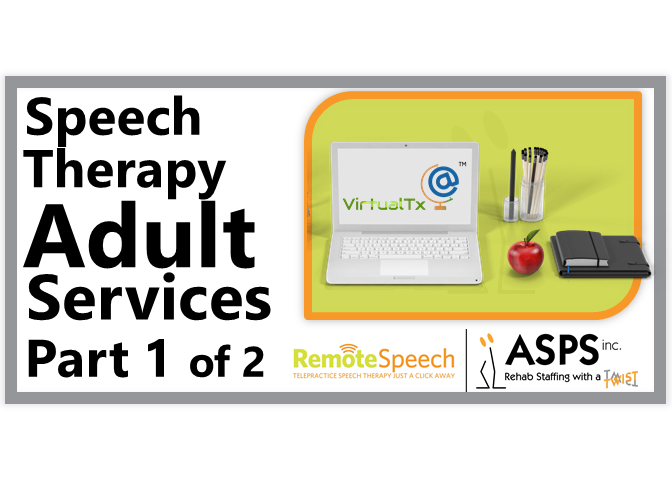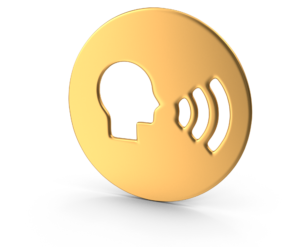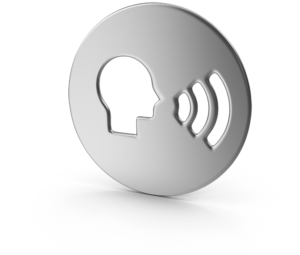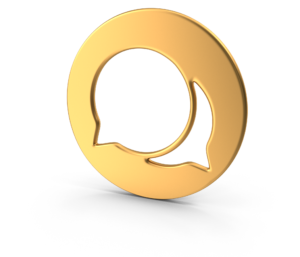
01
Feb
Speech Therapy Adult Services Part 1 of 2
In the world of speech pathology, special care is given to children and adolescents with speech disorders, as it is recognized that both verbal and non-verbal communication play an urgent role in a child’s growth and development. Great care is given to acknowledge the value of a child’s ability to communicate with the world around them. As a result, quantitative research has enabled the industry to make great strides on the value of early intervention. However, the qualitative value (that cannot be measured in numbers) gets less attention. Adults suffering from communication disorders face similar challenges – how do you quantify the value of being able to communicate? What contributions does communication make to a person’s quality of life? How does a communication deficiency affect the individual and those closest to them?
Communication is not a luxury – it is essential. We believe that the first step in addressing stigmas and changing attitudes is through education. In this series, we are going to put a spotlight on speech-language pathology for adults.
We will start by highlighting the leading causes and conditions in adults that could benefit from speech therapy. To accomplish this goal, we have identified the five leading conditions that should be addressed with speech therapy. For each condition, we have taken medical designations and further explained them in relatable terms with which we can easily identify. We seek to ask: How common are these conditions? What are the causes? What are the symptoms? Who are subject to these conditions, and what does treatment look like?
In part 3 of our series, we will examine how effective treatment programs improved the life of the patient by referencing adult patients of RemoteSpeech (we have changed their names and modified their details to remain in compliance with HIPPA regulations).
Also known as acquired apraxia of speech, verbal apraxia, or dyspraxia.
 1. Apraxia of Speech (AOS)
1. Apraxia of Speech (AOS)
Also known as acquired apraxia of speech, verbal apraxia, or dyspraxia.
What it is.
Apraxia is a loss of the ability to use or understand language. Aphasia is an acquired communication disorder that impairs a person's ability to process language, but does not affect intelligence. Aphasia impairs the ability to speak and understand others. This disorder can make saying the right sounds and words very difficult. Apraxia is a motor speech disorder, that varies by complexity. How serious your apraxia depends on what type of brain damage you have. Apraxia can happen at the same time as other speech or language problems. You may have muscle weakness in your mouth. This is called dysarthria. You could also have trouble understanding what others say or telling others what you are thinking. This is called aphasia. As the American Speech and Hearing Association (ASHA) explains:“To speak, messages must go from your brain to your mouth. These messages tell the muscles how and when to move to make sounds. When you have apraxia of speech, the messages do not get through correctly due to brain damage. You might not be able to move your lips or tongue the right way to say sounds. Sometimes, you might not be able to speak at all.”
Apraxia - Types and Causes.
There are two main types of AOS: acquired apraxia of speech and childhood apraxia of speech.- Acquired AOS can affect someone at any age, although it most typically occurs in adults. Acquired AOS is caused by damage to the parts of the brain that are involved in speaking and involves the loss or impairment of existing speech abilities. It may result from a stroke, head injury, tumor, or other illness affecting the brain. Acquired AOS may occur together with other conditions that are caused by damage to the nervous system.
- Childhood AOS is present from birth. This condition is also known as developmental apraxia of speech, developmental verbal apraxia, or articulatory apraxia. Childhood AOS is not the same as developmental delays in speech, in which a child follows the typical path of speech development but does so more slowly than is typical. The causes of childhood AOS are not well understood. Imaging and other studies have not been able to find evidence of brain damage or differences in the brain structure of children with AOS. Children with AOS often have family members who have a history of a communication disorder or a learning disability. This observation and recent research findings suggest that genetic factors may play a role in the disorder. Childhood AOS appears to affect more boys than girls.
Apraxia - How Common is it?
The incidence of apraxia refers to the number of new cases identified in a specific time period. The prevalence of apraxia refers to the number of individuals who are living with AOS in a given time period. There are no reliable data on the incidence and prevalence of AOS in adults due to challenges associated with the common co-occurrence of apraxia with aphasia and dysarthria. Collection of data is also challenging due to difficulty distinguishing among those disorders—particularly in distinguishing between apraxia characteristics and phonological errors that can occur in aphasia. Duffy (2013) observed that Apraxia was documented as the primary, but not necessarily the only, communication disorder for 6.9% of all motor speech disorders in the Mayo Clinic Speech Pathology practice. This percentage would undoubtedly increase drastically if the data included cases in which AApraxia was a secondary communication disorder (e.g., less severe than aphasia or dysarthria; Duffy, 2013; pp. 269–270).Apraxia - What are the Causes?
Apraxia is caused by any process or condition that compromises the structures and pathways of the brain responsible for planning and programming motor movements for speech. Any type of brain damage can cause apraxia. Causes most often include:- stroke,
- traumatic brain injury (TBI),
- tumor,
- surgical trauma (e.g., tumor resection), or
- progressive disease.
Apraxia - What are the Symptoms?
If you have apraxia, you may experience these symptoms:- Distorting sounds. People with AOS may have difficulty pronouncing words correctly. Sounds, especially vowels, are often distorted. Because the speaker may not place the speech structures (e.g., tongue, jaw) quite in the right place, the sound comes out wrong. Longer or more complex words are usually harder to say than shorter or simpler words. Sound substitutions might also occur when AOS is accompanied by aphasia.
- Making inconsistent errors in speech. For example, someone with AOS may say a difficult word correctly but then have trouble repeating it, or may be able to say a particular sound one day and have trouble with the same sound the next day.
- Groping for sounds. People with AOS often appear to be groping for the right sound or word and may try saying a word several times before they say it correctly.
- Making errors in tone, stress, or rhythm. Another common characteristic of AOS is the incorrect use of prosody. Prosody is the rhythm and inflection of speech that we use to help express meaning. Someone who has trouble with prosody might use equal stress, segment syllables in a word, omit syllables in words and phrases, or pause inappropriately while speaking.
- In severe cases, the patient may not be able to say any sounds at all.
Apraxia - What Does Treatment Look Like?
A speech-language pathologist will tailor your treatment regimen to address your specific needs. Treatment might include therapy to improve the following:- Improve how you say sounds and put sounds into words.
- Attention to getting your muscles to move correctly.
- Teach your muscles to make sounds again.
- Saying sounds over and over and using the correct mouth movements
- Slow down your speech or talk to a steady beat so that you can say the sounds you need to say.
Apraxia - Additional Resources
- Acquired Apraxia of Speech (asha.org)
- National Institute of Neurological Disorders and Stroke
- National Institute on Deafness and Other Communication Disorders
 2. Aphasia
2. Aphasia
What it is.
A person with aphasia may have trouble understanding, speaking, reading, or writing.As The American Speech Hearing Association (ASHA) explains: "Aphasia is a language disorder that happens when you have brain damage. Your brain has two halves. Language skills are in the left half of the brain in most people. Damage on that side of your brain may lead to language problems. Damage on the right side of your brain may cause other problems, like poor attention or memory."Aphasia may make it hard for you to understand, speak, read, or write. It does not make you less smart or cause problems with the way you think. Brain damage can also cause other problems along with aphasia. You may have muscle weakness in your mouth, called dysarthria . You may have trouble getting the muscles of your mouth to move the right way to say words, called apraxia . You can also have swallowing problems, called dysphagia.
Aphasia - How Common is it?
- Research suggests that over 2,000,000 Americans currently suffer from some level of Aphasia
- While anyone can acquire Aphasia, most people who have it are in their middle to late years. Men and women are equally affected.
- Aphasia is very common among stroke patients. In fact, approximately one-third of stroke victims will suffer from some sort of Aphasia.
- It is estimated that approximately 80,000 individuals acquire aphasia each year. However, in 2020, the annual rate doubled to 180,000 new cases.
Aphasia - What are the Causes?
Aphasia is most often caused by stroke. However, any type of brain damage can cause aphasia. This includes brain tumors, traumatic brain injury, and brain disorders that get worse over time.Aphasia - What are the Symptoms?
Aphasia can lead to a number of different problems. You may have trouble talking, understanding, reading, and writing.Talking
- Can't think of the words you want to say.
- Say the wrong word. Sometimes, you may say something related, like "fish" instead of "chicken." Or you might say a word that does not make much sense, like "radio" for "ball."
- Switch sounds in words. For example, you might say "wish dasher" for "dishwasher."
- Use made-up words.
- Have a hard time saying sentences. Single words may be easier.
- Put made-up words and real words together into sentences that do not make sense.
Understanding
- Not understand what others say. This may happen more when they speak fast, such as on the news. You might have more trouble with longer sentences, too.
- Find it hard to understand what others say when it is noisy or you are in a group.
- Have trouble understanding jokes.
Reading and Writing
- Reading forms, books, and computer screens.
- Spelling and putting words together to write sentences.
- Using numbers or doing math. For example, it may be hard to tell time, count money, or add and subtract.
Aphasia - What does treatment look like?
Testing for Aphasia
You should see a doctor if you have trouble speaking or understanding what people say. A doctor will determine if there is a medical cause for your problem. A speech-language pathologist, or SLP, will test your speech and language skills. The SLP will ask you about the problems you have and what you want to work on. The SLP will test how well you:- Understand words, questions, directions, and stories.
- Say words and sentences. The SLP will ask you to name objects, describe pictures, and answer questions.
- Read and write. The SLP will have you write letters, words, and sentences. You will also read short stories and answer questions about them.
- Find other ways to share your ideas when you have trouble talking. This may include pointing or using other gestures and drawing pictures.
Treatments for Aphasia
There are many ways to work on your language. The type of treatment you get depends on what you want and need. You may work with an SLP on your own or in a small group. You may want your family to be a part of your treatment. They can help you use the skills you learn with the SLP at home. You may also join a support group or Stroke Club for social activities. Do you speak more than one language? You may talk better in one language and have more trouble in the other. Or, you may have trouble in both. You should work with an SLP who speaks both languages if you can. In severe cases, you may need to find other ways to answer questions or tell people what you want. These may include simple hand gestures, writing, pointing to letters or pictures, or using a computer. This is augmentative and alternative communication , or AAC. The SLP can help you get ready to go back to work or school if that is your goal. You may need to change how you do your work. Or you may need special equipment to help you communicate. Your SLP can work with your boss or teachers to make these changes. See ASHA information for professionals on the Practice Portal's Aphasia page.Aphasia - Other Resources
 3. Dysarthria
3. Dysarthria
What it is.
Dysarthria is a speech disorder caused by muscle weakness. It can make it hard for you to talk. People may have trouble understanding what you say. As ASHA Explains:"We use many muscles to talk. These include muscles in our face, lips, tongue, and throat, as well as muscles for breathing. It is harder to talk when these muscles are weak. Dysarthria happens when you have weak muscles due to brain damage. It is a motor speech disorder and can be mild or severe."Dysarthria can happen with other speech and language problems. You might have trouble getting messages from your brain to your muscles to make them move, (apraxia). You could also have trouble understanding what others say or telling others about your thoughts, called (aphasia).
Dysarthria - How Common is it?
In a recent study, 64% of the 88,974 stroke survivors reviewed were communication impaired:- 28% had both aphasia and dysarthria
- 24% had dysarthria only
- 12% had aphasia only
Dysarthria - What are the Causes?
Brain damage causes dysarthria. It can happen at birth or after an illness or injury. Anything that causes brain damage can cause dysarthria, such as:- Stroke
- Brain injury
- Tumors
- Parkinson's disease
- Amyotrophic lateral sclerosis, or ALS
- Huntington's disease
- Multiple sclerosis
- Cerebral palsy
- Muscular dystrophy
Dysarthria - What are the Symptoms?
Dysarthria results from impaired movement of the muscles used for speech production, including the lips, tongue, vocal folds, and/or diaphragm. The type and severity of dysarthria depend on which area of the nervous system is affected. A person with dysarthria may exhibit one or more of the following speech characteristics:- "Slurred," "choppy," or "mumbled" speech that may be difficult to understand
- Slow rate of speech
- Rapid rate of speech with a "mumbling" quality
- Limited tongue, lip, and jaw movement
- Abnormal pitch and rhythm when speaking
- Changes in voice quality, such as hoarse or breathy voice or speech that sounds "nasal" or "stuffy"
Dysarthria - What Does Treatment Look Like?
Your work with the SLP will depend on the type of dysarthria you have and how severe it is. You may work on:- Slowing down your speech
- Using more breath to speak louder
- Making your mouth muscles stronger
- Moving your lips and tongue more
- Saying sounds clearly in words and sentences
- Using other ways to communicate, like gestures, writing, or using computers. This is augmentative and alternative communication or AAC.





